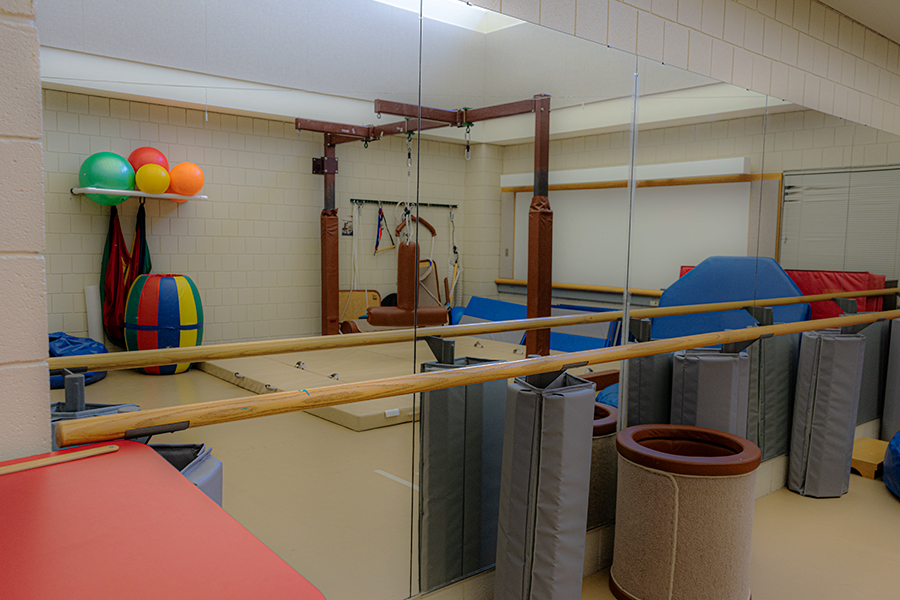The on-campus Physical Therapy (PT) and Occupational Therapy (OT) pediatric clinic at Ithaca College is looking for new patients for Spring 2024. The clinic is open to the children of any faculty, student or community member.
The OT/PT clinic treats patients needing pediatric, orthopedic, neurological and hand therapy. In cooperation with the School of Music, Theatre, and Dance, there is also OT/PT therapy for performing artists. Pediatric PT this semester is scheduled on Thursdays from 3 p.m. to 4:50 p.m. and pediatric OT is available at five different times throughout the week.
Located on the fourth floor of the Center for Health Sciences (CHS), the clinic has been a part of the School for Human Sciences and Human Performance (HSHP) since CHS was built in 1999. It provides pro bono care, meaning they do not bill their patients, and the operational costs of the clinic are funded through the HSHP dean’s office. Kayleigh Plumeau, associate director of clinical education in the Department of Physical Therapy, said the free services grant them the opportunity to serve those who might not otherwise have access to care.
“With a lot of insurances, if you have something like a stroke or another chronic condition, you may only be able to go to therapy for 20, 30 visits,” Plumeau said. “Once they use up those visits, most of these individuals don’t have access to PT anymore. The clinic here allows us to bring some of those individuals to campus to prolong their therapy.”
Plumeau said via email the clinic serves between 150–175 patients per academic year. She said the community should know the clinic is available for them.
“I think a lot of people on campus don’t realize that they can get PT and OT services for their children or family members or friends, and people in the community often don’t know that this is something that we can provide,” Plumeau said.
Jennifer Iglthaler, assistant professor in the Department of Occupational Therapy, said she has worked in the pediatric clinic in previous semesters and mentors students as they work with patients.
“We are very open on what we can work on,” Iglthaler said. “We don’t have limitations like a child might have who is getting services in a school setting; for example, where the services are related to what is going on in the school.”
Interested patients can email the clinic for an intake form. Occupational therapy requires a referral from a doctor, which patients can submit on the clinic’s website. Physical therapy does not require a doctor’s referral, as physical therapists are granted direct access to patients by New York state.
Pediatric PT and OT students create activities that exercise a specific muscle group or mature a child’s development, which often involves games and toys.
“We might be playing a game, but we’re really looking at the child taking turns at using different grasping patterns, navigating the clinic space,” Iglthaler said. “We are looking at it from that deeper point.”
Physical therapy students need to enroll in three Integrated Clinical Education (ICE) assignments between their fourth and fifth years and complete two clinical education placements in their graduate years.
Meghan Mendler is a sixth-year physical therapy student completing her second clinical in pediatric care at Horseheads School District. Mendler’s third ICE placement was at the pediatric clinic on campus, where she said working with a young boy cemented her desire to work in pediatrics.
“I was working in [pediatrics] for … many weeks and I was like, ‘No, this is what I want to do,’” Mendler said. “[It was] getting that time in ICE to work with one little boy and figure out how to make what our goals were, work into what he wanted to do and what he wanted to play with.”
Mendler said she likes the constantly changing nature of working with children and embraces the challenge that comes with being inventive in every appointment.
“You need to have 10 million backup plans in case they don’t want to do anything you set out to do that day, and while that is challenging, I find that it keeps everything more exciting,” Mendler said. “They just look up to you and their face lights up and they’re super excited that they just learned how to do something. You helped them accomplish that.”
The clinical program provides hands-on experience that translates curriculum into practice, something Plumeau said both students and faculty praise.
“[Students can be] in a Monday morning lab where they are learning how to evaluate a patient, and then that afternoon, they are in the clinic with me actually putting those skills to use,” Plumeau said.
Kim Kurr, clinical assistant professor in the School of Health Sciences and Human Performance, works one-on-one with students in the PT pediatric clinic. Kurr supervises the appointments and gives feedback to students on their daily treatment plans.
“I definitely see the progress in the students even from Block I to Block II in the spring semester,” Kurr said. “I think that’s always a big learning curve at the beginning of the ICE section — how to take what they have learned in class and how to do certain exercises and turn it into games and activities.”
Nicole Alduino, a fifth-year physical therapy student, said she has worked in the clinic on campus, across the street at Longview Senior Living Community and Cayuga Medical Center during her time at Ithaca College.
“It is so impactful to see that you’re actually making a difference in their lives and helping them, and even if you can’t see it immediately, they appreciate the effort,” Alduino said via email. “I am so excited to meet more patients and help and connect with more people as time continues.”














